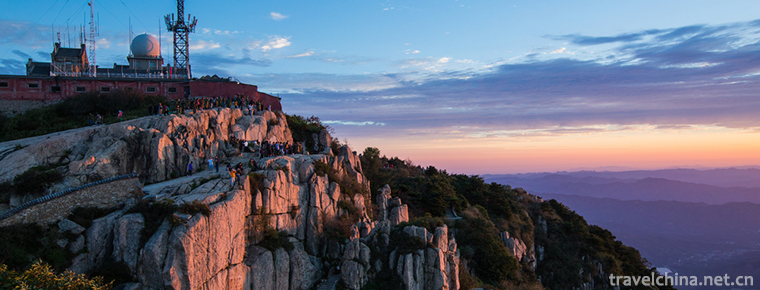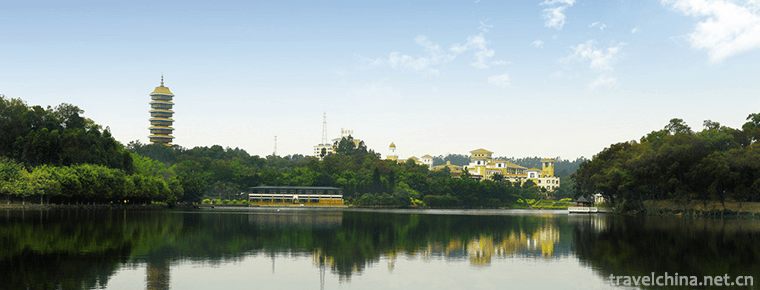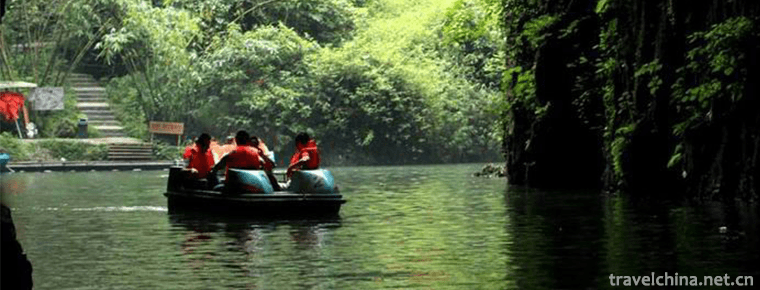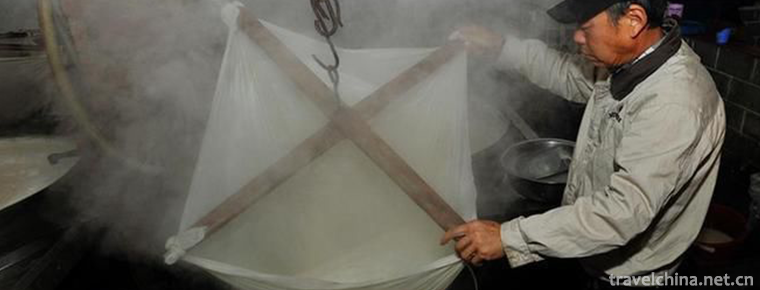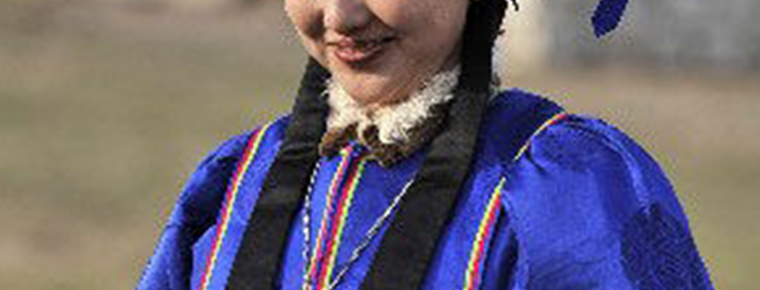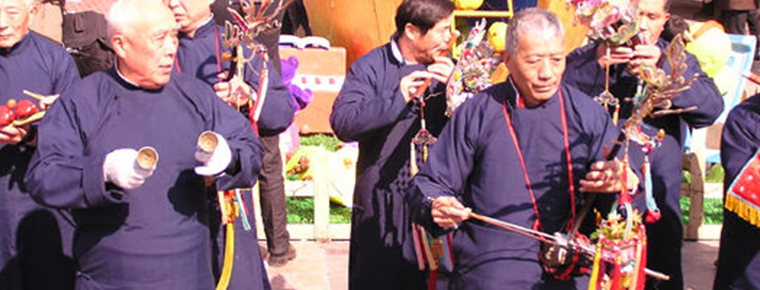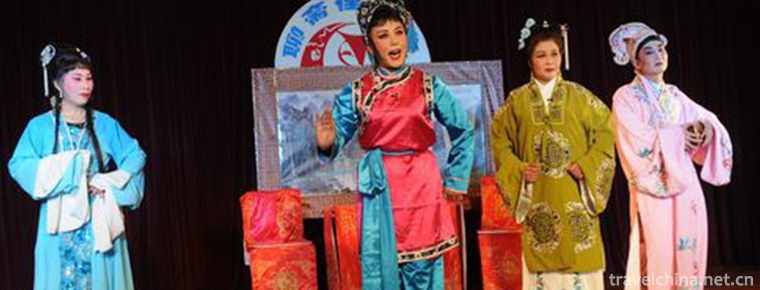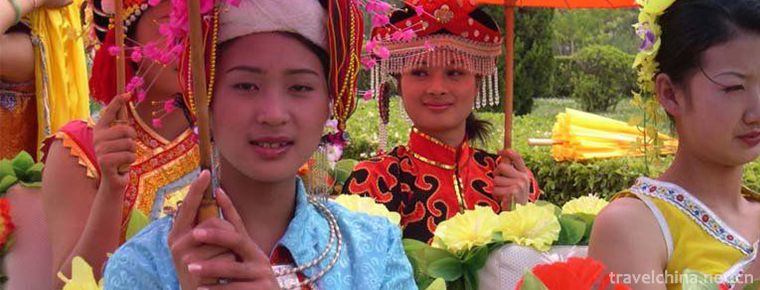Ansai waist drum
Ansai waist drum
Ansai waist drum is a traditional folk dance in Shaanxi Province. Performances can be performed by several people or thousands of people together, magnificent momentum, exquisite performance is intoxicating, known as the world's first drum. In 1996, Ansai District of Yan'an City was named as the township of Chinese waist drum by the Ministry of Culture.
On May 20, 2006, Ansai waist drum was approved by the State Council and listed in the first batch of national intangible cultural heritage list.
origin
The form and development of Ansai waist drum are inseparable from the local historical and geographical environment and customs. Ansai District is located in the north of Yan'an City, Shaanxi Province. It is a typical loess plateau landform with vast territory, ravines running vertically and horizontally, and the Yanhe River winding through the territory. Historically, it is an important military town, known as "Shangjun throat" and "North Gate Key", which is one of the frontier fortresses to resist foreign invasion. Local people said that as early as the Qin and Han Dynasties, waist drums were regarded as indispensable equipment by garrison officers and men as weapons, bows and arrows. When the enemy raids, they beat drums to warn and send messages; when the two armies confront each other, they use drums to encourage them; when the battle is won, the soldiers celebrate with drums. With the passage of time, the waist drum has gradually developed from military use to a folk dance when local people pray for gods, wish harvest and celebrate the Spring Festival, thus making it more popular. However, in the style and performance of drum beating, it still retains the vigorous and heroic posture of some Qin and Han generals.
Development
In 1981, on a hillside called "Tomb collapse" in Wangzhuang Village, Liangcun Township, Yan'an City, which is adjacent to Ansai County, an ancient tomb was found while cultivating land. Two portrait bricks of waist drum with the same shape and figure shape were unearthed, all of which were fired after being molded. It was identified by experts of cultural relics and Archaeology in Yan'an area as a creation of the Song Dynasty. The drummer shaped on the brick portrait is thin waist drum, side body, head raised to the left and back, left foot touching the ground, right leg front striding out, hands one high and one low as a hammer drum swinging; on the left side, one person is a drummer beater, feet jumping up, sucking left leg, eyes looking at the left side, hands doing Bracelet in front of the chest. The drummer was bare, wearing knickers and a ribbon around his waist, and floated to the front and bottom. Especially the drummer's action and image are quite similar to the fourth beat of "horse step and pedal" and the second beat of "advance" in Ansai waist drum nowadays. The lumbar drum portrait brick has clear pictures and beautiful shapes. It vividly shows the performance of lumbar drum in northern Shaanxi in Song Dynasty. It provides precious and detailed cultural materials for the study of the historical origin and development of lumbar drum in northern Shaanxi.
In 1942, the new Yangko Movement which sprang up in Yan'an and Shaanxi-Gansu-Ningxia Border Region developed the Ansai waist drum, an ancient folk art, and became a symbol of celebrating victory and liberation for hundreds of millions of soldiers and people. It was also known as the "Victory waist drum", which spread all over China and was recorded in the glorious history of the revolutionary literary movement. In 1951, Ansai waist drum participated in the national folk music and dance performance. Folk artists such as Aixiushan of Fengjiaying Village in Ansai taught the skills of waist drum to the Chinese Youth Literary Troupe. After performing at the World Youth and Student Festival held in Budapest, Ansai waist drum won the first prize, which made Ansai famous at home and abroad.
Waist drum is a traditional form of encouragement widely spread in northern Shaanxi, especially in Ansai County, Yulin Hengshan, Mizhi and other places. It is one of the most influential dances in Shaanxi folk dance. Ansai waist drum originated in Hengshan, Yulin. In the late Ming Dynasty, due to famine and peasant uprising, Ansai was already sparsely populated, and Ansai people moved from Hengshan, Yulin. Come here and bring Yokoyama's waist drum to Ansai. Ansai waist drum is a unique traditional folk large-scale dance art form with a history of more than 2000 years, and it is a national intangible cultural heritage. The unique charm of the Ansai waist drum image has set off a frenzy on the loess. Hong Kong has shown its elegance in all parts of China and attracted worldwide attention. The bold and rugged movements and vigorous and bold dancing gestures fully reflect the simple, simple, brave and powerful personality of the people in the northern Shaanxi Plateau. Ansai waist drum can be performed by thousands of people. As early as 1986, Ansai waist drum won the highest honor award of the first Chinese folk dance competition. It performed in the opening ceremony of the 11th Asian Games, the celebration of the return of Hong Kong, the celebration of the national celebration in 2009 and other large-scale activities, and went to Japan, Germany and other countries to perform.
The waist drum in northern Shaanxi has a broad mass base and a long history of development. In some main districts, almost all villages have drums and drummers. And it has been handed down from generation to generation and lasts forever. Because of its long spread, wide range and large number of participants, the basic forms and rhythms of dance are roughly the same, but in different regions, different performing styles and customs have been formed. Ansai waist drum is one of the representative.
Ansai waist drum has a long history. It was originally used by the ancient army to increase morale and transmit information. Here it is used to express the joy of victory and harvest. The sound of drumming, the strong pace, the changeable position and the grand shout all show the beauty of male masculinity, which is very famous in the world.
Social Evaluation and Demonstration
The opening program of the large-scale literary and artistic evening of "Song for the People" in 2012 is Ansai waist drum from the revolutionary holy place of Yan'an, which is well-known both at home and abroad.
Ansai waist drum, known as "the first drum in the world", has a long history. During the revolutionary period, it was called the "victory drum". When the people in the revolutionary base areas welcomed Chairman Mao and the Red Army of Workers and Peasants and celebrated the victory, they jumped up with great momentum. At the beginning of the reform and opening up, the performance of Ansai waist drum became a highlight of the opening ceremony at the 1990 Beijing Asian Games, and it has been praised up to now. Ansai waist drum witnessed the changes of the times in China. As the opening program of the large-scale literary and artistic evening "Song for the People" held in commemoration of Comrade Mao Zedong's "Speech at the Yan'an Literature and Art Symposium", it was of extraordinary significance.
Ansai is located in northern Shaanxi. It is said that in ancient times, the frontier guards and soldiers used waist drums to cheer in battle and celebrate after victory. With the passage of time, waist drum has gradually become a recreational activity, especially during the festival, people use waist drum to celebrate the harvest and increase the festive atmosphere. Ansai waist drum participants are generally male. There are two forms. One is road drum, that is, beating while walking, the other is ground drum, performing in square, stage and designated place. Many drummers wear wool towels, red ribbons around their waists, drums around their waists, and hammers in both hands. With the accompaniment of drums, gongs, brass cymbals and suonas, they leap left and right, jump vividly and show the sincere enthusiasm of the Loess Plateau, which is the cohesion and explosion of strength.
Ansai waist drum originated from war or sacrifice, and later evolved into traditional folk entertainment, which has a history of more than 2,000 years. Ansai waist drum can be played by several to thousands of people together is very spectacular. Ansai waist drum is one of the top three in Ansai. In 1996, Ansai County was named "the hometown of Chinese waist drum" by the Ministry of Culture.
Style and characteristics
Ansai waist drum is famous all over the world for its unique style, bold and rough, vigorous and unrestrained, magnificent momentum. It organically combines Yangko and Wushu movements, fully demonstrating the Loess people's simple, brave, brave and optimistic character. The performance of Ansai waist drum is neither restricted by the venue nor by the number of personnel. On the road, in the square and on the stage, performances can be performed, either singles or doubles, or dozens or even hundreds of people. Singles leap and spin, sometimes like a clear dragon, sometimes like a spring swallow holding mud, sometimes like a fierce horse galloping, sometimes like a tiger showing prestige; when fighting in groups, they can change a variety of wonderful patterns, such as wild horse rabbit cross-country.
Waist drum category
Ansai waist drum is divided into two kinds: Wengu and Wugu. Wengu mainly focuses on twisting and lightly beating, while Wugu mainly focuses on beating and lightly beating. Ansai waist drum fast release and fast recovery, change speed, natural generosity, happy and smooth, rigid and flexible, flexibility, in the process of development and evolution of dance, martial arts, gymnastics, percussion, wind music, folk songs and so on into one, so that their content to form more rich, more ornamental, entertaining.
Ansai waist drum mostly uses the form of collective performance, drummers (known as "dragging drums" or "kicking drums") a few dozen people, more than a hundred people. The team includes Lahuahua actress, umbrella head, barbarian mother, barbarian and other roles, and "running donkey", "boat", and other small programs to form a vast folk dance team. In the performance, it emphasizes the overall effect, requires the uniformity of movements and the standardization of formation changes, mainly through the heroic and rough dancing and powerful drumming skills of drummers, fully demonstrates the masculine beauty of men living on the Loess Plateau.
custom
Ansai waist drum has complete performance procedures and activities. In the past, performances were mostly performed in festivals and temple fairs, and the annual Spring Festival to Lantern Festival was the time for concentrated activities. Before the beginning of the event, the temple fair will be organized by the president of the temple fair (from all villages) to be organized as a "worship Temple". Under the guidance of the umbrella head, the dance team will beat the gong and drum, blow the suona, and sometimes carry the whole pig and other offerings to the temple to burn incense and worship. Pray for the gods to protect the wind and rain, and the country and the people. And in the temple square kicked for a while, in order to entertain the gods. After the end of the "Temple of Appreciation", the waist drum team began the door-to-door New Year celebration activities, commonly known as "along the door" after the eighty-ninth day of the first lunar month. There is a local proverb: "gongs and drums are ringing, sticks are prying under the buttocks!" The masses can not sit down. At this time, the waist drum team in accordance with the situation of the village in turn, in the main courtyard, kiln before performing for a while, umbrella head according to the situation of each family, touching the scene and singing a few Jili Yangge, in order to express the meaning of the New Year. Households believe that waist drum team into the hospital knocking, dancing and singing, can eliminate disasters and avoid disaster, four seasons of peace. This may be the custom of the ancient "Nuo of villagers". Sometimes two teams of drums meet on the way. Umbrella heads usually sing Yangko to each other to celebrate the New Year and make way for each other. But sometimes there will be situations where they can't make way for each other. Now they have to compete in competitions and compete for heights and heights. The gongs and drums of the two teams are playing like spring thunder rolling with the sound of Suona and waist drums. Drummers beat and jump like madness to the climax. Drum music is temporarily rested. The two sides'umbrella heads appear to sing to each other. This is also an aspect of competition skills. Until a team of corner chaos, uneven movements, drums, formation are not unified or can not answer the song, even if lost, so take the initiative to give way, let the winner go first.
After the end of "Yanmenzi", the waist drum teams in the neighboring villages also pay New Year's greetings to each other, visit each other and perform exchanges. This is called "the Gate of Painting" as the Yangge in northern Shaanxi. On the 15th day of the first lunar month, the village waist drum teams gathered in the square and began to compete with each other. Each drummer shows his own skill and compares with each other, which has become the climax of waist drum performance in one year. This not only activates the rural Spring Festival recreational activities, but also promotes the popularization and improvement of waist drums by watching and discussing skills with each other. On that night, there will also be a "turning light" (also known as "turning nine tunes"), which is almost everybody's contest and the whole family will turn around together. At that time, the drums were singing, the lights were flashing, and the waist drum team was leading. Then, the crowd presented a lively and extraordinary scene.
The activities of the waist drum troop often lasted until the seventeenth and eighteenth day of the first lunar month, when the sacrifice to the God of land ended. Since then, the villagers have been at ease to prepare for spring farming production.
Form of performance
The performance forms of waist drum can be roughly divided into "road drum" and "field drum".
"Road drum" is a kind of performance form of the waist drum team while walking and dancing. The former is led by two umbrella leaders, followed by a drummer who is closely followed by the head of the dance team B-umbrella made up of drums and lahua. He is called "head drum". He must be a skilled drummer. The movements and rhythms of the whole team change rapidly and slowly, and are all directed by him. The rear part of the team is a clown disguised as a pretty man and a man. Some of them are disguised as Sun Wukong, pig and so on. "Road drum" because of the performance in progress, the general movement is simple, the range is small, do more "cross step", "walk step", "horse step around waist? Commonly used formations are "single cross street", "double cross street", "single dragon tail swing", "double dragon tail swing" and so on.
"Site drum" refers to the performance form after the waist drum team arrives at the performance site and opens the stage. At the beginning, the umbrella was waved by the umbrella head, and the drums were singing together. The dancers danced with the umbrella head. This section is called "Staying on the Stadium". The performance is slow. The purpose is to open the venue, open the team and stabilize the mood of the audience. The second part is singing and dancing. The rhythm of the performance is getting faster and faster. The movement range is larger and the formation changes a lot. Commonly used formations are "Shenlou", "Ancient Temple", "Gold Medal hanging in front of the god", "rich and honorable head", "monk's traveling door" and so on. After drawing out the "solar arc" pattern, the umbrella head stands in the center of the audience to lead the singing of Yangko. The lyrics depend on the occasion and the object. When visiting the temple, there are temple worship rituals. Generally speaking, performances include greeting the audience on New Year's Day, celebrating harvest and wishing good luck. When the umbrella head sings, the dancers walk around slowly and repeat the last sentence of each paragraph, commonly known as the "follow-up tone". After singing, the umbrella head exits the venue and enters the venue to perform by drumming and pulling flowers, out of various complex and changeable formations. At this moment, without the limitation of time, the dancers show their unique skills to the full, warm mood, ups and downs, so that the performance reaches its climax.
Ansai waist drum in order to highlight the skills of dragging drums, performing "field drums" by dragging drums alone in the field. Under the command of drummers on the front road, drummers are energetic and energetic. At this time, they only see drumsticks waving, colored silk flying, drums thundering, shaking the earth, pressing and very infectious.
At the end of this period, performances of other forms of small shows, such as "Donkey Running", "Water Boat", "Stilts", "Two Ghosts Fighting", "Big Head Monk" and so on, will be interluded. The number of program forms depends on the talents and conditions of each village. After the small show, a big waist drum was performed. At the moment, gongs and drums are beating faster, suonas are blowing tightly, drums are beating more intensely and emotions are more cheerful, which makes the whole performance end in a strong atmosphere and high mood.
Style rhythm
Ansai waist drum according to different styles and rhythms of the original text, martial arts, "Wenwaist drum" relaxed, lively, small action range, similar to the style of Yangko; "Wuwaist drum" is cheerful and intense, rough and unrestrained, and has greater kicking, jumping and rotating movements, especially the drummer's flying skills, give people a sense of heroism and surge. Wen and Wu waist drums gradually combine to form a new style, with Xihekou Township in Ansai and Zhenwudong as the two most distinctive places. They vividly reflect the local people's simple and honest temperament and character characteristics. Especially in the performance, folk Wushu and Yangko dance are organically blended. They are relaxed, lively but not chaotic, orderly, powerful and vigorous. The masses praised it as "generous style and hard code".
Features
The style characteristics of Ansai waist drum can be summarized as follows:
1. Express the dancer's heart through the change of rhythm. Dancers can't help shaking their heads and shoulders slightly when beating drums, so that their inner feelings and external rhythms can be organically combined to achieve both spiritual form and harmony.
2. Dancers swing hammers and drums with great strength. Whether they hit up, down or around the waist, they should throw the drumsticks away with both hands. But although ruthless but not barbaric, it appears upright and thick, and still has its delicate feeling in vigor;
3. When doing kicks and jumps, no matter big kicks, small kicks or kicks, there must be a "barbaric" strength. The rhythm is cheerful and difficult, which represents Ansai waist drum's bold and bold style.
4. Turning around the drum is the key to Ansai waist drum performance. In dancing, every squat and kick must turn around. When turning around, it must be fierce. Especially when doing a combination of jumping and landing squat, turning around and starting at the same time, it must be in a fixed rhythm and use rapid vigor to complete the change and connection of movements.
5. The rhythm shape is complex and the jump range is large. With the acceleration of the rhythm of the performance, the footsteps begin to complex kick and jump, and increase the range of the body's left-right swing. For example, when performing such actions as "horse step kicking leg", "double turn" and "horse step jumping", the dancer uses bow step to jump back twice, then strides forward with his left leg, kicks up with his right leg, and leaps like a dragon, showing a spirit of tenacious struggle.
Drum-carrying costumes are similar to those of traditional operas, in which Wusheng wears black tightly-fitting boastful clothes, straw hat rings, beards, blushes, thick eyebrows and beards. With the change of the times, dancers'clothes are also changing. The waist drum costumes around Xihekou Township are close to life, while the clothes of Zhenwudong Waist Drum Team still retain the costumes of ancient warriors, wearing heroic scarves, waist-girdled war skirts and red-muffled shoes, which are quite similar to those of soldiers and generals in ancient battlefields.
Ansai waist drum is accompanied not only by the drums beaten by the dancers themselves, but also by folk drums and bands. The instruments include drums, cymbals, gongs, etc. There are also suona playing cards, and the commonly used music cards are Soushan Ling.
Inheritance status
Ansai waist drum is a traditional folk square group art spread in Ansai County, northern Shaanxi Province. It shows the enthusiasm of the people in northern Shaanxi. It is a unique and representative art form of folk art in northern Shaanxi Province. In the long-term spread process, it has formed the characteristics of bold, bold, powerful, vigorous, vigorous, vigorous, vigorous, powerful, graceful, graceful, graceful, flowing and elegant, quick and unrestrained, relaxed, group but not chaotic, changeable and so on. Ansai waist drum is a combination of dance, martial arts, gymnastics, percussion, wind and folk songs. It embodies the joy of the people of northern Shaanxi after winning the victory and harvest, and integrates the simple, honest, optimistic and cheerful character of the people of the Loess Plateau. At the same time, it is the reappearance of the spirit and features of the Chinese nation, and a part of the culture of the Yellow River Basin. Therefore, it is not only deeply loved by the broad masses, but also famous overseas. It can be called "China's first outstanding" and "China's first drum". Ansai waist drum from the countryside to the city; from the Loess Plateau to the north and south of the river; from the farmyard to Tian'anmen; from self-produced to film and television screens; from the agricultural games to the Asian Games; from the poor mountain ditch in northern Shaanxi to the world podium. Ansai waist drum with its unique and exquisite art throughout the country, out of Asia, to the world.
Ansai waist drum is quite popular in Ansai County. It is distributed in Tanjiaying, Xihekou, Yanhewan, Zhenwudong and other townships. It can be divided into the South and the north. About half of the 150,000 people in the county can play waist drum. In addition to young people, there are children, old people and women. In order to promote this excellent folk art, Ansai County has established the "Ansai Waist Drum Art Association" and established branches in various townships. There are more than 1000 members. The Office of the association is located in the county cultural bureau. It mainly undertakes various foreign exchange and performance tasks. As early as 1986, Ansai waist drum won the highest honor award of the first Chinese folk dance competition. It performed in the opening ceremony of the 11th Asian Games, the celebration of Hong Kong's return and other large-scale activities, and went to Japan to perform. Ansai waist drum performance can be performed by several people or thousands of people together. Its magnificent momentum and exquisite performance are intoxicating. It is called "the first drum in the world". In 1996, Ansai County was named "Town of Chinese Waist Drum" by the Ministry of Culture.
The reality of Ansai waist drum is worrying and needs to be protected and supported.
Major events
In the 1940s, waist drum teams and Yangko teams from Gaoqiao Township, Ansai County, visited Zaoyuan, Yangjialing to pay New Year's greetings to Chairman Mao, Zhou Enlai and other central leaders and Red Army officers.
After Mao Zedong's speech at the Yan'an Literature and Art Symposium on May 23, 1942, Lu Yi's cultural workers transformed Ansai's waist drum. The content and form of Ansai's waist drum changed profoundly. The ancient warrior style was ended in clothing, and "white mutton, scarf and red belt" became the external characteristics of waist drummers. From then on, women entered the Yangko and Ansai waist drum performing troop.
From 1947 to 1949, the "Victory Drum" adapted from Ansai's waist drum was brought to the south of the Yangtze River by the Red Army officers and soldiers, namely the PLA.
On October 1, 1951, Cai Weijie and Cao Huaiyong of Feng Jiaying and Guo Jiamaozi of Ansai County walked back and forth for more than 50 days. Under the name of "Shaanxi Performance Troupe to Beijing", they blessed the People's Republic of China in Tiananmen Square, which had just been established for two years. Mao Zedong, Zhu De, Zhou Enlai, Liu Shaoqi, Deng Xiaoping and other state leaders and people from all walks of life in the capital watched the performance. During the performance, the performers of the Central Youth Arts and Works Corps and Ansai waist drummers learned the skills of Ansai waist drum.
In 1952, at the Budapest World Youth and Student Festival, the Ansai waist drum performed by the Chinese Youth Art and Works Group won a gold medal and honor for the new China.
In 1959, Ansai waist drum participated in the shooting of the large-scale music and dance epic "Oriental Red". Successful shooting!
From 1966 to 1976, during the Cultural Revolution, especially during the breaking of the Four Old Ages, folk arts such as waist drum suffered a certain impact, and the activities of waist drum almost disappeared.
Since 1974, Ansai waist drum began to perform. Towns and townships (communes) paid attention to the training of movement and skills, and at the same time, in order to win the competition, great reforms have been made in the color, style and headdress of clothing. The waist drum has also moved from the self-made stage of "imitating the structure of war drum, cutting willow, hollowing out city drum, covering cattle and sheep skin on it" to the stage of social purchase, and the self-made stage of waist drum. The history of disunity is basically over in Ansai.
In 1979, Ansai waist drum, composed by Yu Zhiming of Ansai Cultural Museum and others for "Ansai County Mao Zedong Thought Propaganda Team", won the first prize for performance and creation in amateur literary and artistic performances of Shaanxi Province.
In 1981, a number of portrait bricks of waist drums and Yangko were unearthed in Liangcun, Yan'an City (now Baota District).
In the spring of 1982, the Central Committee, Shaanxi Province and other relevant units came to Ansai to record the scene of Ansai waist drum.
In the spring of 1983, the Central Song and Dance Troupe went to Shanwanghe Village in Xihekou to watch the waist drum performance, and gave guidance to the waist drummers from the angle of dance. On the 15th of January, the Central Song and Dance Troupe again came to Shanwanghe Village to celebrate with the waist drummers.
In 1983, represented by the waist drum team of Tanjiaying Township, Ansai County, participated in Yangko waist drum and folk song performance in Yan'an area, and won the second place.
In 1983, Yangko and waist drum portraits of bricks from Song Dynasty unearthed in Yucha Township, Ganquan County, are almost the same as Yangko and waist drum in action, pace, gait and props nowadays.
In 1984, Ansai County took the waist drum team of Xihekou Township as its representative team, participated in Yangko and waist drum performances in Yan'an area, and won the first prize.
Around 1984, some Eastern Han Dynasty stone reliefs were unearthed in Suide, Mizhi and other places in Yulin area. Among them, "beating drums and dancing pills" and "beating whips and drums" all have the figures of waist drum today. According to time, it should be the first year of AD, about two thousand years ago.
From March to April 1984, Ansai County Primary School Children's Waist Drum Team participated in the National Children's Song and Dance Television Movie Competition, won the second prize of Shaanxi Province and the second prize of the whole country, and had a party with Japanese children while performing in Xi'an.
In May 1984, the Ansai Waist Drum Team, with farmers as the main body, participated in the filming of the feature film "The Yellow Land", directed by Chen Kaige and photographed by Zhang Yimou. Drummers rehearse and perform for two days, each paying 7 yuan. Ansai waist drummers were paid for the first time. In 1984, when the "Loess Land" crew entered Ansai, which is still relatively closed. Here they are looking for a kind of folk dance that matches the Loess and is full of the motive force of life. They chose the waist drum. On the day of filming, 150 sturdy northern Shaanxi men in black jacket trousers, white mutton towels and red cloth belts at the waist, stepping on thick loess, were encouraged by cowhide drums. They move forward, backward, kick, turn around, move around like nobody's land, brave as a tiger, roll over like a dragon, fluent and incisive, flying and surging. The crew were shocked and intoxicated. When the last shot was taken: drummers surging up from behind the hillside, yellow dust rolled up, people were in a trance, the thunderous drums and the roar of 150 men mingled together, like the roar of the Yellow River and the galloping of ten thousand horses. The people present applauded enthusiastically and were almost mad with excitement. From then on, Ansai waist drum irremediably beat out the Yellow earth.
In February 1986, the waist drum team of more than 800 people performed for the large-scale TV series "Yellow River" co-produced by China and Japan on Baiping Mountain and Baoxiaotan, three miles east of the county seat. The head of Ansai waist drum and Hukou Waterfall of the Yellow River are used as the film's opening lens.
In August 1984, more than 100 teachers and students from Hong Kong and Macao came to Ansai to watch the waist drum performance.
On December 7, 1986, Ansai waist drummer Liu Yanhe, Tan Haize, Bai Guangdong and others performed Ansai waist drum. They participated in the "National Folk Music and Dance Television Competition" jointly organized by the Ministry of Culture and CCTV, and won the grand prize with absolute advantage. Since then, the name "Ansai waist drum" has been called throughout the country.
In 1986, Ansai waist drum won the highest honor award in the first Chinese folk dance competition.
In the spring of 1987, Ansai waist drum participated in CCTV evening party and was the first show to appear. There are 8 drummers, including Liu Yanhe, Tan Haize and Bai Guangdong.
In September 1989, more than 300 waist drummers performed at the opening ceremony of the First National Peasant Games. In the autumn of the same year, 260 waist drummers participated in the performances of literary and artistic performances of the China Tourism Festival held in Xi'an.
In September 1989, Ansai waist drummer participated in Beijing International TV Week and performed many times in China Grand Theatre and other places. The shots of this performance, as one of the titles of CCTV's "Rotating Stage", have been used for nearly three years.
On September 22, 1990, 425 Ansai waist drummers participated in the first large-scale international games held by the Chinese government. The opening ceremony of the 11th Asian Games "gathered in Beijing" was a large-scale literary and artistic performance, which was highly praised by the distinguished guests of all countries participating in the Asian Games and officials such as Olympic Committee Chairman Samaranch. Jiang Zemin and other central leaders also watched the performance.
On August 21, 1991, Ansai waist drum participated in the opening ceremony of the Ninth Shaanxi Games.
In May 1992, Ansai waist drum participated in Shenyang International Drum Culture and Art Festival.
In April 1993, Ansai waist drum participated in the closing ceremony of China International Fashion Festival held in Beijing Tiantan Park to pray for the New Year.
From September 8 to September 11, 1993, Ansai held the First Lumbar Drum, Suona, Folk Song Grand Prix, in which 18 lumbar drum teams participated.
In October 1994, the first book on Ansai waist drum, Ansai waist drum, was published by China Peace Publishing House and edited by Zhang Xinde.
On October 1, 1994, Ansai waist drum participated in the celebration of Tiananmen Square on the 45th Anniversary of the National Day of the People's Republic of China. Jiang Zemin was appointed as the Standing Committee, member of the Political Bureau of the Central Committee and leader of the Party, government and army in time. Ambassadors from various countries in China and people from all walks of life in the capital watched the performance. CCTV also carried out live broadcasting. On October 2, the Ansai Waist Drum Team went to the Great Hall of the People to give a special performance for Jiang Zemin and other leading comrades of the Central Committee.
In November 1996, Ansai County was named "the hometown of Chinese folk waist drum art" by the Ministry of Culture of the People's Republic of China.
In September 1997, Ansai County held the second Folk Art Festival. The county's 20 drum teams competed in the County Stadium drum contest.
On July 1, 1997, Ansai waist drum performed brilliantly at the Hong Kong Return Ceremony in Victoria Harbour, Hong Kong. On July 2, it rained down to perform for the people of all walks of life in Hong Kong. More than 200,000 Hong Kong residents watched the show in the rain.
In May 1998, the Ministry of Culture of the People's Republic of China awarded Ansai County the title of "National Advanced Culture County" after carefully examining the work of folk arts such as waist drum and cultural construction of the whole county.
In September 1999, Macau middle school students'waist drum team, coached by Ansai waist drum artists, performed at the celebration of Macao's return.
On September 10, 1999, 600 Ansai waist drummers attended the opening ceremony of the Fourth City Games of the People's Republic of China.
On September 13, 1999, 300 Ansai waist drummers performed for the CCTV National Day Literature and Art Gala in Yan'an.
From September 25 to October 5, 1999, 40 Ansai waist drummers participated in the performance of Shaanxi Zhou in Kunming World Expo.
On the morning of October 1, 1999, 17 Ansai waist drummers on the "Shaanxi" float performed to the central leadership, envoys stationed in China and the people from all walks of life in the capital during the mass parade after celebrating the 50th anniversary of the founding of the People's Republic of China. This is the first time that Ansai waist drum has performed on a float.
At 7.30 p.m. on October 1, 1999, 120 Ansai waist drummers jointly celebrated the 50th anniversary of the founding of the People's Republic with literary and artistic delegations from all provincial central ministries and commissions in Tiananmen Square. Ansai waist drum is the first program in the first edition. Ansai Waist Drum Team was awarded as an excellent performing group by the General Command of the celebration of the 50th anniversary of the founding of the People's Republic of China.
On October 2, 1999, 137 Ansai waist drummers participated in the national, army and model workers'performance in front of the Workers' Cultural Palace and Taimiao Temple. Jiang Zemin, Hu Jintao and other central leaders attended the performance.
On December 29, 1999, 180 Ansai waist drummers participated in the large-scale celebration of "Thousand Faces Gong and Drum Welcome 2000" in Shaanxi Province.
On January 5, 2000, 260 waist drummers from Ansai participated in the recording and performance of CCTV literary and artistic programs.
In April 2000, Ansai waist drum participated in the "King of Chinese Drum" contest held by CCTV at the film and television base of Wuxi CCTV, and won the title of "King of Chinese Drum".
During the Spring Festival of 2001, Ansai Folk Art Troupe went out of Shaanxi for the first time as a whole and performed the program represented by Ansai waist drum at Guangxi Tourism Art Festival.
On April 10, 2001, Ansai Folk Art Troupe performed Ansai waist drum and other performances at the opening ceremony of Xi'an East-West Trade Fair.
On May 31, 2001, the Ansai Folk Art Troupe performed nine programs, such as the Ansai waist drum, in the Staff Club Auditorium of Baoji Cigarette Factory, which were accepted and approved by officials of the Ministry of Culture, the Information Office of the State Council, the China Foreign Performance Corporation and the Berlin Municipal Government of Germany. The Ansai Folk Art Troupe was identified as one of the literary and artistic groups representing the Chinese Government in the "Berlin Asia-Pacific Week".
From September 20 to October 1, 2001, the Ansai Folk Art Troupe performed the Ansai waist drum at the Palace Square, the Moon Garden, the Mercedes-Benz Building and the Cultural Square in Berlin, which stirred up Berlin and overwhelmed German audiences.
In October 2001, Ansai waist drum went to Yichang, Hubei Province for a commercial performance.
From September 20, 2001 to November 20th, the Ansai folk art troupe hosted a two month commercial performance at the Yu Garden in Shanghai, which was dominated by Ansai waist drum.
During the Spring Festival of 2002, the Ansai Folk Art Troupe, featuring the Ansai waist drum, performed a one-month commercial performance in Ocean Park, Hong Kong, and participated in the New Year's Street stamping activities of all walks of life in Hong Kong.
In June 2002, Ansai Waist Drum Team, on behalf of Yan'an Municipal Government, participated in the "Red Ship Art Festival" in Jiaxing, Zhejiang Province.
In July 2002, Ansai waist drum participated in Nanjing Cultural Tourism Art Festival.
In February 2003, Gao Zhanxiang and more than 20 other authoritative figures of Chinese folk literature and art activities gathered in Ansai to discuss the tourism development of Ansai waist drum.
In August 2003, Chen Peiliang and his children Chen Yonghong, Chen Qiang, Chen Gang, Chen Hongmei and Chen Lei performed the Ansai waist drum for the Olympic propaganda film shooting team directed by Zhang Yimou.
In September 2003, Ansai waist drum participated in the Qingdao International Beer Festival, the literary and artistic performances of the celebration of the centennial celebration of Qingdao Beer and the large-scale celebration performances in the square.
In November 2003, Ansai County Folk Art Association successfully declared the trademark registration of "Ansai waist drum" to the Trademark Administration Bureau of the State Administration of Industry and Commerce, registering 111 trademarks of 12 categories.
In December 2003, Ansai Waist Drum, the first collection of photographic works of Ansai Waist Drum, was published by Hong Kong Zhengxuan Culture and Art Publishing House, by Shania.
From January 12 to January 17, 2004, the National Photography Golden Week of "New Year's Day in Northern Shaanxi" was co-sponsored by China Art Photography Association, People's Photography Newspaper, Ansai County Committee and Ansai County People's Government, aiming at publicizing Ansai waist drum and folk art, and the National Photography Grand Prix of "Ansai Cup" was successfully held. Nearly 1,000 waist drummers in Ansai conducted square, mountain, street crossing and old-fashioned events. Middle-aged, women, children waist drum and other performances. The event was a great success. More than a dozen TV stations, such as CCTV, Hong Kong Phoenix Satellite TV, and newspapers and magazines all over the country, published more than 50 sets of special topics and news and nearly 100 pictures of various kinds. More than 280 photographers from all over the country and from Japan, Canada and Hong Kong participated in the event.
From January 20 to February 3, 2004, Ansai Folk Art Troupe, at the invitation of the Thai Government, participated in the Chinese Government's cultural brand promotion activities in Bangkok, Thailand.
From 6 to 9 February 2004, at the invitation of the New Zealand Government, Ansai waist drum participated in the Fifth New Year's Lantern Festival in Albert Park, Auckland, New Zealand. During 18 performances in three days, New Zealand's Head of State, Prime Minister Clark, arrived from Wellington by plane. After watching the Ansai waist drum performance, she met all the waist drummers and shook hands with everyone and took pictures. In this event, Ansai waist drum and Maori dance symbolizing New Zealand performed together for 30 minutes.
In June 2004, 22 meters high, the huge Ansai waist drum, designed and constructed strictly according to the proportion of waist drum, broke ground on Dongdun Mountain in Ansai County. The giant waist drum is part of the "Loess Style" leisure tourism resort and is the largest drum building in China at present.
On February 3, 2004, photographers were filming an Ansai waist drum performance. From February 2 to February 7, Ansai County, Yan'an City, Shaanxi Province, held the Golden Week of Photography for the Spring Festival in Northern Shaanxi. Hundreds of photographers from home and abroad gathered to photograph folk activities such as Ansai waist drum, paper-cut and marriage in northern Shaanxi.
On October 1, 2004, Ansai waist drum participated in the performance of a large-scale literary party celebrating the 55th anniversary of the founding of the People's Republic of China.
On January 21, 2005, Ansai waist drum participated in the "Tianding Cup" Yellow River style photography contest.
On May 1, 2005, Ansai waist drum participated in the special exhibition of Shaanxi folk culture and folk art dragon.
On December 12, 2005, Ansai waist drum took part in the long march.
On January 28, 2006, Ansai waist drum participated in the opening of the 23rd Beijing Longtan Temple Fair, which lasted eight days and was full of strong folk customs, customs and customs.
On March 11, 2006, 400 waist drummers attended the opening ceremony of China Super League.
On February 15, 2007, Ansai waist drum participated in the "2007 Valeta Chinese Spring Festival" series held in Valeta, Malta.
At the end of March 2007, at the invitation of the Chinese Embassy in Peru and the Peruvian Chinese Association, Ma Cunming, from Xihekou Township, Ansai County, went to Lima, the capital of Peru, to teach Ansai waist drum art. During the three-month training activities, more than 50 students from Peruvian Chinese Association, primary and middle school students from Ruowang 23 Chinese-American School and young employees of WONG Supermarket Group were trained successively.
On September 15, 2007, the opening ceremony of the 18th Shanghai Tourism Festival of Ansai Waist Drum was held. The event, consisting of 21 floats and 33 domestic and foreign performing teams, attracted more than 140 performers from Australia, the United States, France, Germany, Luxembourg, Brazil, Mexico, Japan, the Philippines, Malaysia and Thailand, and attracted 460,000 Chinese and foreign tourists.
On November 2, 2007, he participated in the Second China-Jiaxing Jiangnan Culture Festival.
On February 10, 2008, Sydney, Australia participated in the "2008 Chinese Spring Festival Tour" organized by the local government.
On May 9, 2008, he participated in the parade performance of "Yangko Dancing for the Olympic Games" held in Qingdao.
On July 2, 2008, Ansai waist drum participated in the torch relay of the Beijing Olympic Games and the Yan'an Revolutionary Holy Land relay ceremony.
In September 2008, Ansai waist drum participated in the first Chinese Ansai Loess Culture and Art Festival.
In February 9, 2009, Shaanxi Ansai drum team with Chinese national customs performed in front of Shanghai Oriental Pearl TV Tower. Their bold and bold movements change, vigorous and unrestrained vigorous dance, playing the blessing of spring.
On March 30, 2009, Ansai waist drum participated in the opening ceremony of China-Wuxi Yangshan (International) Peach Blossom Festival.
On April 20, 2009, Ansai waist drum participated in the 10th China-Shandong International Vegetable Expo.
On May 23, 2009, Ansai waist drum participated in the Second Chinese Poetry Festival.
On June 24, 2009, Ansai waist drum participated in the Red Classic Concert of "Songs on the Screen" jointly organized by the Chinese Filmmakers Association and the Chinese Musicians Association.
On August 6, 2009, Ansai waist drum participated in the ceremony of collecting sacred earth at Yan'an Station, the fifth station of the 11th National Games.
On August 27, 2009, Ansai waist drum participated in the victory ending ceremony of the long march road.
On October 1, 2009, thousands of Ansai waist drums participated in a mass March to celebrate the 60th anniversary of the founding of the People's Republic of China.
On October 17, 2009, the opening evening of Nanning International Folk Song Art Festival and the 6th China-ASEAN Exposition, Earth Flying Song 2009, was held.
On November 18, 2009, Ansai waist drum participated in the 9th Happy Festival in Hainan, China.
On March 24, 2010, Ansai County established the first cultural company specializing in excavation, collation, protection, inheritance and promotion of Ansai waist drum, Ansai Northern Shaanxi Cultural Communication Co., Ltd.
On September 18, 2010, Beijing Tsinghua University launched a theme cultural activity called "Ansai waist drum into Tsinghua". Ansai County sent six waist drum coaches to Tsinghua University, and conducted Ansai waist drum training in postgraduate classes of Tsinghua University.
On November 6, 2010, 40 waist drum players organized by Ansai Waist Drum Company in North Shaanxi participated in the opening ceremony of the third Chuzhou Farmers'Song Festival in Anhui Province.
On June 11, 2011, the People's Day in Chengyang City, Qingdao, Shandong Province, invited 50 members of Ansai Waist Drum Company in northern Shaanxi Province to attend the opening ceremony.
On July 1, 2011, Ansai waist drum participated in the 2nd China Ansai Loess Culture and Art Festival. From June 30 to July 2, a grand performance was performed in the large-scale live performance of Dancing Yan'an at the launching ceremony of Loess Culture Park.
On the Lantern Festival in February 2012, Henan Lingbao Municipal Government invited 120 waist drum players from Ansai Waist Drum Company in northern Shaanxi Province to perform for the citizens in Hangguguan Scenic Area.
On the Lantern Festival in February 2012, the Yuxian Government of Yangquan City, Shanxi Province, invited 100 members of Ansai Waist Drum Company in northern Shaanxi Province to perform Ansai Waist Drum.
On October 1, 2012, Ansai waist drum participated in the opening ceremony of the National Day of Horse Racing held by the Hong Kong Jockey Club.
On January 1, 2013, the book Ansai Waist Drum, co-authored by Zhang Xinde, one of the founders of Nanchuan School of Three Art Systems of Ansai Waist Drum, and Zhang Xizhi, the builder of the landmark building "Waist Drum Tower" in Ansai County, was officially published and published by Shaanxi People's Publishing House. Bai Yunteng, formerly deputy director of the Standing Committee of the Shaanxi Provincial People's Congress,
On July 4, 2013, students from Tsinghua University came to Ansai Yaogushan Sports Plaza in Yan'an City, Shaanxi Province, and jointly presented a new drum dance performance with the local farmers Ansai Yaogushan Team.
On October 27, 2013, the 16-member Ansai Waist Drum Team stood on the stage of Dolby Theatre at the Academy Awards in Los Angeles, USA, to show the charm of Ansai Waist Drum.
Inheritance significance
The unique charm of Ansai waist drum elephant raises the craze on the loess, demonstrates the simple and bold character of the Northwest Loess Plateau peasants, and publicizes the unique artistic personality. In Beijing, the capital of China, and in Hong Kong, it shows its elegance in China and attracts worldwide attention. The bold and rugged movements and vigorous and bold dancing gestures fully reflect the simple, simple and brave personality of the people in the northern Shaanxi Plateau. Ansai waist drum is an integral part of the Yellow River culture. It is a manifestation of the plagiarism, tiger strength and cow strength of the Han people in northern Shaanxi. It has a very national style and regional characteristics.




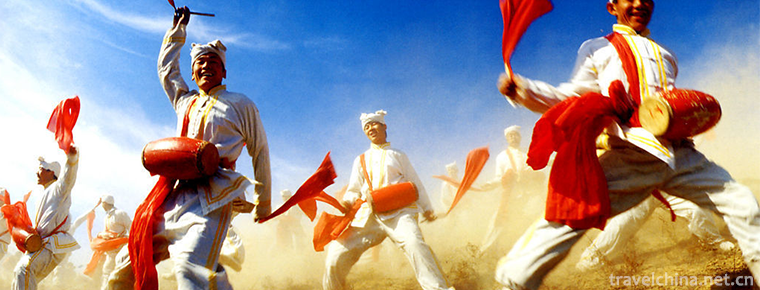
-
Mount Tai
Mount Tai, also known as Daishan, Daizhong, Daiyue, Dongyue, Taiyue, is located in the central part of Shandong Province, belonging to Tai'an City, stretching between Tai'an, Jinan, Zibo, with a total.
Views: 249 Time 2018-10-28 -
sanshui forest park
Sanshui Forest Park is located in the north suburb of the southwest town of Sanshui District, Foshan City, Guangdong Province..
Views: 142 Time 2018-12-18 -
Shimen Xianhu Scenic Area
Shimen Xianhu Scenic Area is the first national 3A-level tourist scenic spot in Rongan County, located in Liuzhou, Guangxi. It has high Gorges out of Pinghu Lake.
Views: 117 Time 2019-02-08 -
Legend of Boya Period
"When the evidence of the legendary place of Bo Yazi Period was found in Hanyang, I knew that it was hopeful to apply for the national level!" Yesterday, the reporter learned from the Provin.
Views: 210 Time 2019-04-04 -
Traditional Manufacturing Techniques of Tofu
The traditional craft of tofu production is a traditional handicraft with a long history. Refers to the various methods of making tofu, tofu can be fried and stewed at will, lasting.
Views: 128 Time 2019-04-28 -
Ewenki costumes
The Ewenki people belong to the Tungusic race, and their clothing materials are mainly animal skins, as do the Tungusic people such as Manchuria and Xibo..
Views: 265 Time 2019-04-28 -
Jiangnan bamboo
Chinese traditional instrumental music, silk and bamboo, is popular in southern Jiangsu and Zhejiang. After the Revolution of 1911, great progress was made in Shanghai.
Views: 113 Time 2019-05-05 -
Liao Zhais folk songs
The spreading area of Liaozhai slang mainly distributes in Zibo City, Shandong Province. The Pu family and its descendants are the main inheritors. Liaozhai slang is a unique traditional folk music li.
Views: 195 Time 2019-05-13 -
Nu Fairy Festival
Fairy Festival is a traditional folk festival of Nu people in Gongshan area of Yunnan Province. The local flower festival, also known as the Flower Festival, is held on March 15 of the lunar calendar .
Views: 289 Time 2019-06-08 -
wolong national nature reserve
Wolong Nature Reserve is located in the southwest of Wenchuan County, Aba Tibetan and Qiang Autonomous Prefecture, Sichuan Province, on the southeast slope of Qionglai mountains, 130 kilometers away from Chengdu.
Views: 250 Time 2020-11-06 -
Overview of Guangyuan
In 2019, the GDP of Guangyuan will reach 94.185 billion yuan, an increase of 7.5% over the previous year, which is the same as that of the whole province. Among them, the added value of the primary industry was 15.301 billion yuan, an increase.
Views: 350 Time 2020-12-15 -
Biological resources in Dazhou
There are more than 400 species of vertebrates in Dazhou City, including 60 kinds of mammals, 230 kinds of birds, 14 kinds of reptiles, 10 kinds of amphibians and 85 kinds of fish. There are 52 species of national and provincial key protected wild an.
Views: 363 Time 2020-12-20
